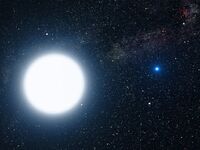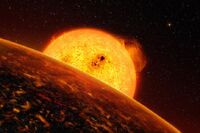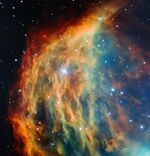| Constellations (9) | |
|---|---|
| Aries, Auriga, Canis Major, Canis Minor, Gemini, Lepus, Monoceros, Orion, Taurus | |
| Nomenclature | |
| Abbreviation | Arn |
| Genitive | Arani |
| Pronunciation | Name: /'ār•ān•ē•(y)is/ Genitive: /'ār•ān•ī/ |
| Symbolism | the spider |
| Geometry | |
| Midpoint right ascension | 04h 59.96m |
| Midpoint declination | +11° 27.22' |
| Northernmost border | +56° 09.49' |
| Southernmost border | −33° 15.03' |
| Westernmost border | 01h 46.62m |
| Easternmost border | 08h 11.69m |
| Quadrant | NQ1 |
| Crossed by | Ecliptic Equator Summer meridian |
| Bordering caelregios | Avis (N) Hippocampus (SW) Felis (E) Malus (SE) Selachimorphus (S) Testudo (NW) |
| Segments | 48 |
| Area | 4339.308 sq. deg. (4th) |
| Proportion of the sky | 105.188‰ |
| Average constellation area | 482.145 sq. deg. (6th) |
| Stars | |
| Named stars | 61 |
| Stars in the figure | 11 |
| Naked eye stars (m < 6.50) |
504 |
| BF stars | 546 |
| Bright stars (m < 3.00) |
32 |
| Brightest star | Sirius (−1.46m) |
| Nearby stars (D < 10.00 pc, 32.62 ly) |
30 |
| Nearest star | Sirius (2.64 pc, 8.60 ly) |
| Messier objects | 12 |
| Visibility | |
| Full visibility range | 56°N–33°S |
| Partial visibility range | 90°N–56°N 33°S–90°S |
| Midnight culmination date | December 6 |
| Zodiac | |
| Astrological sign | 3/21–6/21 |
| Solar sign | 4/19–7/20 |
Araneus is a caelregio located in the first quadrant of the northern hemisphere at its midpoint, but it extends into the southern hemisphere and into the second quadrant. Araneus is divided into nine constellations (listed in the infobox).
Araneus contains one of the most magnificent constellations, Orion. In addition, Araneus also contains the sky's brightest star Sirius as well as numerous other bright stars, competing with Simianus for the brightest caelregio. Six of the bright stars make up the Winter Hexagon, which is the most complex and recognizable seasonal asterism. This caelregio contains numerous examples of deep sky objects including the Pleiades (the most famous open cluster) and two most famous nebulae: the Orion Nebula and the Crab Nebula. Combining all of these features would make Araneus the most conspicuous caelregio.
Symbolism[]
Araneus is named after the Latin word for spider, even though there are no spider-related constellations. It can be imagined that spiders were eaten by ram (Aries), dogs (Canis Major & Canis Minor), hare (Lepus), and bull (Taurus). For Gemini the Twins, spider crawl from one member to another via connected arms while biting.
Notable stars[]
Bright stars[]
Araneus contains the sky's brightest star Sirius at a magnitude of −1.46, which is an A-type main sequence star located in the constellation Canis Major, and is also the Araneus' nearest star (sixth nearest star system overall) at a distance of 8.60 light-years (2.64 parsecs). Sirius is one of the stars that make up the Winter Triangle, the other two are Procyon and Betelgeuse, both will mention below, which means that all the stars that make up the Winter Triangle are located in this caelregio. There is also the Winter Hexagon with the component stars Sirius, Procyon, Pollux/Castor, Capella, Aldebaran, and Rigel, all of these will mention below. Like the Winter Triangle, every component stars that make up the Winter Hexagon are located in Araneus.
Betelgeuse is a red supergiant located in Orion. It is expected to go supernova within a million years. With the magnitude of 0.58, it is the second brightest star in Orion and eighth brightest overall. The star radiates 140,000 times quicker than our Sun and it is 498 light-years from Earth. Betelgeuse is the first star other than our Sun to have its angular diameter measured in 1920, the estimate ranges from 43 to 58 milliarcseconds. Rigel is a B-type supergiant also located in Orion. With the magnitude of 0.12, it is the brightest star in Orion and sixth brightest overall. Rigel is 117,000 times more luminous than our Sun and it is 863 light-years away. Also in Orion, Bellatrix is a B-type giant.
Aldebaran is an orange giant located in Taurus. Its diameter is 44 times that of the Sun and it is 425 times more luminous than our Sun. Aldebaran is one of the four brightest stars within 5° of the ecliptic, the others are Spica in Noctua, Regulus in Felis, and Antares in Simianus.
Castor and Pollux are a pair of brightest stars located in Gemini. Castor is a white star while Pollux is an orange star that was once a white star like Castor. Castor is 51 light-years away while Pollux is 34.
Capella is the brightest star in Auriga and third brightest star in the northern sky after Arcturus and Vega. The brightest member of the four-star system is a yellow giant. Procyon is the brightest star in Canis Minor and the seventh brightest in the sky at 0.34m. It is an F5IV-V star with seven times the energy output of the Sun.
Nearby stars[]
The only notable nearby star in Araneus other than Sirius is Gliese 229, which was the first star known to be orbited by a brown dwarf. Gliese 229 is a red dwarf 18.77 light-years (5.75 parsecs) away in the constellation Lepus.
Variable stars[]
The prototype variable star T Tauri can be found located in the Hind's Variable Nebula to be mentioned below. T Tauri varies unpredictably in magnitude from 9.3 to 14. Like all T Tauri stars, T Tauri is very young, at only a million years old. The Sun was probably a T Tauri star within a few million years of Sun's birth.
Another notable T Tauri star is R Monocerotis. The magnitude varies between 10 and 12. This "star" is not more than a very bright concentration of gases within the Hubble's Variable Nebula to be mentioned below. Some star atlases and sky catalogue do not list R Mon as a star, but a nebula.
The prototype variable star SX Arietis can be found. This type is the high temperature version of α2 CVns. This star varies by about 0.1 magnitude at around one day and has a strong magnetic field and an uneven surface distributions of helium.
Epsilon Auriga is an eclipsing binary system. Every 27 years, the magnitude drops from 2.92 to 3.83 which lasts 640–730 days. BG Geminorum contains an eclipsing binary between a black hole and a K-type star.
There is the Orion variable star AE Aurigae. It is a runaway star that may have ejected from the Trapezium Cluster in the Orion Nebula two million years ago. AE Aur is currently surrounded by the Flaming Star Nebula to be mentioned below.
VY Canis Majoris is 1800–2100 times the diameter of the Sun, making it the biggest star known. This red hypergiant star is also a semiregular variable with a period around 2000 days or between five to six years.
Betelgeuse is a semiregular variable varying between magnitudes 0.2 and 1.2 as the star pulsates. Betelgeuse has the greatest magnitude variation of any first magnitude stars. FU Orionis is a pre-main sequence star with extreme changes in brightness and spectral type.
Multiple stars[]

A main sequence star Sirius A and a white dwarf companion Sirius B
Sirius contains the stellar companion Sirius B, which was the first white dwarf discovered in 1915. The two white stars orbit around the center of mass at a distance of 20 AU (about the Sun–Uranus distance) and takes 49.9 years to revolve. To resolve two individual stars of Sirius, at least a 12-inch telescope would be needed as the angular separation is between 3" to 11".
In Gemini, the sextuple star system Castor can be found. It contains two spectroscopic binaries and two eclipsing binaries. This system contains three A-type stars and three M-type stars.
In Auriga, the brightest star Capella is a multiple star system comprising of four stars with two binary pairs –– two yellow giants and two red dwarfs.
In Canis Minor, Procyon is a binary system comprising of an F-type main sequence star and a white dwarf. Since the angular separation is only 1.232", a large telescope would be needed to resolve two stars of Procyon.
Gamma Arietis is a triple star system comprising of a binary pair and a binary orbiter. The binary period is greater than 5000 years and both A-type main sequence stars are separated by 7.7 arcseconds, which is separable in small telescopes. The third member is 221 arcseconds distant, 29 times further separated from the pair than the members of the pair, which can be separated using just the unaided eye. Robert Hooke discovered one of the first double-star systems in 1664.
Planetary systems[]

COROT-7b (Icarus, P311)
There are nearly a hundred exoplanets identified around approximately 70 stars in Araneus. Two notable examples are Pollux (P15 Arn), which contains a giant planet Remus (P181) on a 590-day orbit, and Hamal (P47 Arn) in Aries, which contains a giant planet Marzanna (P520) on a 381-day orbit.
A more notable example is COROT-7 (P30 Arn) in Monoceros, which contains two confirmed super-Earths (respectively COROT-7b (Icarus, P311) and COROT-7c (Daedalus, P338)) and one unconfirmed midplanet (COROT-7d (Tutelina, P434). All three would orbit within 0.1 AU. Icarus was found by transit, while Daedalus and Tutelina were found by radial velocity from HARPS. Both Icarus and Daedalus are so-called lava planets while Tutelina is blue and cloudless.
A strange example is WASP-12 (P23 Arn), located in Auriga, which has a dying planet WASP-12b (Vulcan, P262) because the star is devouring the planet. Vulcan orbits at a distance of only 1⁄44 the Earth–Sun distance and takes 1.09 days or over 26 hours to orbit. Vulcan has mass 1.39 MJ and radius 1.83 RJ, yielding a mean density 1⁄4 that of water or 1⁄21 that of Earth. Scientists expect that Vulcan will be devoured in 10 million years.
Another notable exoplanet is 30 Arietis Bb (Ino, P374), which orbits the star 30 Arietis B (P36 Arn, component of the 30 Arietis system) at an average distance of 0.98 AU and 29% eccentric. This planet has mass 12.95 MJ and 10% larger than Jupiter in diameter, corresponding to a mean density 13.2 g/cm3, 10 times denser than Jupiter.
In Taurus, HD 37124 (P1 Arn) has three giant planets with changing dynamics caused by gravity between the planets.
Notable deep sky objects[]
Araneus contains the famous open clusters Pleiades (M45), which contains seven bright blue stars, called the "Seven Sisters," and Hyades (Mel 25, C41), both located in Taurus. Also located in Taurus, the Crab Nebula (M1, NGC 1952) is a remnant of a supernova after the progenitor star exploded in 1054, which was observed by Chinese astronomers. Another supernova remnant, in Gemini, is the Jellyfish Nebula (IC 443). Located in Monoceros, we find the Christmas Tree cluster (NGC 2264), which contains the Cone Nebula (NGC 2264), which is an HII region. This nebula is dark and diffuse.
In Gemini, we find the typical open cluster M35. In Auriga, we find the open cluster M37 along with two other open clusters: M36 and M38. In Canis Major, we find the open cluster M41 which contains several red giants.
The famous Orion nebula (M42, NGC 1976) is a stellar nursery located in Orion. This nebula contains the Trapezium Cluster at its heart, which is a tight open cluster of young stars formed out of the parent nebula. This constellation also contains the Horsehead Nebula (B33), which is a famous dark nebula where stars are forming, the Flame Nebula (NGC 2024), which is an emission nebula, and the Monkey Head Nebula (NGC 2174), which is a planetary nebula. In Auriga, there is the Flaming Star Nebula (IC 405, C31), which is a reflection/emission nebula surrounding the irregular variable star AE Aurigae mentioned above.
The Bug Nebula (NGC 2346) is a bipolar planetary nebula located near the equator in Monoceros. In Gemini, the Eskimo Nebula (NGC 2392, C39), also known as the Clownface Nebula, can be found using a small telescope, which is a planetary nebula. Another planetary nebula in Gemini is the Medusa Nebula (Abell 21, Sh2-274).
In Canis Major, Thor's Emerald Helmet (NGC 2359), which is an interstellar bubble, can be seen. The Rosette Nebula (NGC 2237, C49), which is one of the most massive stellar nurseries at around 10,000 solar masses, can be found in Monoceros using the binoculars.
The planetary nebula Red Rectangle Nebula (HD 44179) can be found in Monoceros. Also in this constellation, there is the Seagull Nebula (IC 2177), which is an emission nebula. Another emission nebula Barnard's Loop (Sh2-276) and reflection nebula M78 are found in Orion.
There are two examples of planetary nebulae in Taurus: the Vulture Head Nebula (B207), which is a dark nebula, and Crystal Ball Nebula (NGC 1514), which is a planetary nebula. There is the Gourd Nebula (Sh2-308) in Canis Major, which is also a planetary nebula.
Located in Taurus, Hind's Variable Nebula (NGC 1555) is a variable nebula illuminated by the prototype variable star T Tauri. Another notable variable nebula, located in Monoceros, is Hubble's Variable Nebula (NGC 2261, C46) illuminated by the variable star R Monocerotis.
In Canis Major, we observe that two spiral galaxies NGC 2207 and IC 2163 are currently in the first stage of galactic collision. In about a billion years, the two spiral galaxies will become one elliptical galaxy. Also in this constellation, there is the Canis Major Dwarf discovered in 2003, which is the nearest [irregular] galaxy to the Milky Way at just 25,000 light-years distant. This galaxy contains about one billion stars, many of which are red giants.
Gallery[]
 The Pleiades (also known as the Seven Sisters) (M45) |
 The Hyades (Mel 25, C41) |
 The Crab Nebula (M1, NGC 1952) |
 The Horsehead Nebula (IC 434) |
 The Orion Nebula (M42, NGC 1976) |
 |
 The Rosette Nebula (NGC 2237, C49) |
 The Eskimo Nebula (also known as the Clownface Nebula) (NGC 2392, C39) |
 The Bug Nebula (NGC 2346) |
 The Flame Nebula (NGC 2024) |
 The Christmas Tree Cluster (NGC 2264) |
 The Cone Nebula (NGC 2264) located in the Christmas Tree Cluster |
 The Red Rectangle Nebula (HD 44179) |
 Thor's Emerald Helmet (NGC 2359) |
 The Flaming Star Nebula (IC 405, C31) |
 The colliding galaxies NGC 2207 (left) and IC 2163 (right) |
 The Jellyfish Nebula (IC 443) |
 The Medusa Nebula (Abell 21, Sh2-274) |
Notable meteor showers[]
Every year on December 13–14, the Geminids (also called December Aranids) peak, caused by the asteroid 3200 Phaethon. This meteor shower is intensifying every year and recently seen 120–160 meteors per hour.
Every year on October 20–24, the Orionids (also called October Aranids) peak, caused by the famous comet Halley. It can often produce 20–70 meteors per hour.
Every year on June 7, the Arietids (also called June Aranids) peak, caused by the asteroid 1566 Icarus. It can produce 54 meteors per hour.
Every year on November 3, the Taurids (also called November Aranids) peak, caused by the Comet Encke. It can produce about 7 meteors per hour. Because of their occurrence from late October till early November, they are often called Halloween fireballs.
Visibility[]
In the northern hemisphere, Araneus can be visible during the fall and winter months. A significant portion of this caelregio can be observed from around the world because Araneus is an equatorial caelregio, but a larger portion is more prominent in the northern hemisphere because the area of Araneus north of the equator is greater than the area south of the equator.
The most prominent constellation in this caelregio is Orion, which contains the Orion's belt of three stars and the sword. Araneus is one of the brightest and most recognizable caelregios with all but one constellation containing at least two bright stars (m<3.00).
Zodiac[]
The Sun appears to cross Araneus from April 19 till July 20: it crosses the constellations Aries (April 19 till May 13), Taurus (May 14 till June 19), and then Gemini (June 20 till July 20). This zodiacal caelregio is located between Hippocampus to the west and Felis to the east.
Araneus was formerly in the sign of zodiac from March 21 till June 21.
| |||||